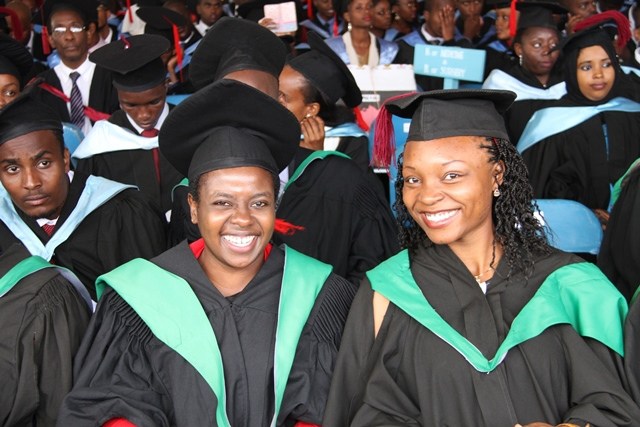After a year of silence, work is finally ramping up on the launch of the first global education financing facility (IFFEd), intended to catalyze US $10billion from the multilateral development banks in a bid to reverse the growing education crisis.
United Nations Secretary-General António Guterres met with the heads of the major multilateral development banks and representatives from the Education Commission on Friday to officially endorse the International Finance Facility for Education.
First mooted by the Education Commission in 2015, more details are now beginning to emerge about the instrument, which could be launched by the end of the year.
At the meeting in New York recently, youth activists from countries in the “global south” handed over a petition with more than 1.5m signatures calling for IFFEd to be launched. Guterres lauded it as one way of channeling “more and better funding for education to achieve our full potential,” according to a press release.
Presented as the education sector’s answer to the Global Fund to Fight AIDS, Tuberculosis and Malaria, and Gavi, the Vaccine Alliance, IFFEd is designed to help fill the yawning education financing gap by combining guarantees and grants from donor countries to enable the major MDBs to lend more to lower-middle income countries committed to investing in their education systems. It is hoped it will create places for an initial 20m children who are currently out of school.
The commission describes the mechanism as pioneering and says it has never been tried before. It claims the approach will be efficient, affordable, scalable, and sustainable.
Not everyone in the education sector is convinced, however. Questions have been raised about the technical feasibility of the mechanism and whether it can raise the necessary funding from donor countries at a time of shrinking aid budgets.
Civil society groups and some potential recipient countries fear IFFEd will increase government debt levels and could interfere with existing education financing mechanisms namely the Global Partnership for Education and Education Cannot Wait. Some say the commission should focus on alternative ways of increasing financing for education, such as through international and domestic tax reform.
The campaign begins
IFFEd was first proposed as one of three recommendations in the commission’s influential 2015 Learning Generation report, which shone a spotlight on the global learning crisis.
According to UNESCO, 264 million children are out of school, and the United Nations estimates that a further 600m are in school but learning little. Aid spending on education is falling far short, with UNESCO saying an extra US $39 billion will be needed every year to meet the Sustainable Development Goals on education by 2030.
IFFEd seeks to turbo-charge investment from multilateral and bilateral donors, who currently spend just US $12 billion a year on education.
The commission’s director, Liesbet Steer, told Devex that IFFEd has been keeping a low profile in recent months so as not to distract from GPE’s replenishment fundraising, which culminated in January, and the World Bank’s successful campaign for a capital increase, concluded last month.
Still, technical work, consultations, and negotiations have continued behind the scenes, to develop a model that is both “feasible” and acceptable to the parties involved, something Steer said was “tricky” since this type of model has “never been done before.” The commission is developing a draft technical note and recently published a prospectus and draft set of principles. Current plans will see IFFEd established as a lean operation of about 10 staff, potentially based in Switzerland due to its “favorable regulations,” Steer said.
Steer told Devex she was encouraged to see growing momentum for the global education agenda among MDBs and donors. “We’re always talking about building bridges and roads, but if you look at the wealth of nations now, 70 per cent will lie in human capital,” she said. MDBs are now in “much greater agreement” on this, she suggested, as shown on Friday when the African, Asian, and Inter-American Development Banks, the European Bank for Reconstruction and Development, and the World Bank all signaled their support for IFFEd.
Donor governments are also showing positive signs, Steer added. “We’ve had a lot of very positive conversations with different European countries and also Japan,” she said, and hope to have an “initial signal” from donor countries by the end of June.
The missing middle
The plan is for IFFEd to target a specific group of lower-middle income countries, including Côte d’Ivoire, Vietnam, Kenya, Pakistan, and Guatemala. These countries are home to 700 million girls and boys of school age, more than three times the number in lower-income countries, but receive the least international support for education.
They are in a “tight spot,” Steer said, since they are no longer able to access concessional finance but are yet to “get their tax revenue up.” LMICs receive about US $1.5 billion a year for education from MDBs, while often unable to access grants from GPE and ECW.
Faced with the choice of borrowing at higher interest rates for education versus infrastructure, finance ministers tend to opt for the latter since education provides “fuzzy and longer-term returns,” Steer said.
IFFEd is being developed to help fill that gap, by insuring MDBs to provide more education loans at cheaper rates to these “missing middle” LMICs. It is intended to act as “bridge financing” to enable them to keep investing in their education systems during this critical stage of their development, Steer explained.
She predicts IFFEd could mobilize an additional $10b in new financing delivered annually by 2020, which could rise to US $20 billion by 2030.
It will require donor countries — likely to be mostly European — to put up guarantees of US $2 billion and grant financing of an additional US $2 billion, although only 10 to 15 per cent of the pledge money will need to be paid in cash, Steer said. The guarantees will enable MDBs to raise additional financing from capital markets — thanks to their high credit ratings, they could potentially leverage this at four times — while the grants will be used to buy down the loans and convert them into credits, making borrower countries more likely to borrow.
However, accessing IFFEd financing will come with conditions. In order to qualify, countries must show they have credible education sector plans; have the capacity to take on the extra lending without running into “debt distress;” show they are committed to increasing their domestic expenditure to education; and be willing to integrate results-based approaches.
The model will also require a shift in thinking among donors and MDBs, Steer said.
“The whole idea of using donor guarantees, or contingent liabilities, to insure the portfolios of MDBs is entirely new,” she said. In the past, donors have tended to provide one-to-one guarantees, but IFFEd would require them to provide loss insurance across the whole nonconcessional lending portfolio of an MDB.
Civil society groups have questioned whether governments are able to use their aid budgets for this kind of deal. It also means bringing together ministers of finance and development in donor countries, which Steer said is often “not straightforward.”
Complications and concerns
For MDBs to get good leverage within the markets IFFEd will need a strong credit rating — and achieving this will depend on a number of legal and technical factors, as well as a coordinated push for IFFEd from MDBs, Steer said. She plans to approach ratings agencies in late 2018.
“We need to have a better narrative around debt … CSOs tend to think education should never be financed with debt … but the kind of debt we are providing is very cheap.”
Liesbet Steer, director of the Education Commission
There are also complexities around whether IFFEd-financed activities, if funded by guarantees, can be classed as official development assistance under the OECD-Development Assistance Committee regulations, which would dictate whether donor countries can contribute to the facility through their aid budgets. The issue is currently being explored by the Total Official Support for Sustainable Development initiative, part of OECD-DAC, which is looking more broadly into tracking and classifying financing from public and private donors that contributes to the SDGs.
But even if this issue is resolved, some NGOs have raised serious concerns about the IFFEd model.
Save the Children’s recently published policy brief on IFFEd, which includes a call for greater focus on equity and universalism, raised concerns that the instrument could increase countries’ debt vulnerability. The Global Campaign for Education has also raised broader questions about IFFEd’s focus on mobilizing MDB financing for education. It calls instead for “more balanced efforts on other aspects of financing, including clearer targets on domestic financing and tax justice,” according to David Archer, head of public services at Action Aid, a founding member organization of GCE.
IFFEd’s principles state that “debt financing is not appropriate for all countries.” But realistically, Steer said, it is often the only option in terms of boosting education flows.
“We need to have a better narrative around debt … CSOs [civil society organizations] tend to think education should never be financed with debt … but the kind of debt we are providing is very cheap,” she said.
“The choice is either we don’t invest [in education] or we use very cheap debt,” Steer said, adding that debt sustainability has been built into IFFEd’s design. “As these countries develop, they lose access to cheap grants and IDA,” but “tax revenues are not growing fast enough.” Through IFFEd, countries can avoid going to more expensive capital markets to bridge the gap, and can instead access lower interest rates from MDBs, subsidized by IFFEd.
Repayment of the loans will also happen “many years down the line when the children educated today will be earning an income, which creates tax revenue,” said Steer. The idea is to “use a tiny fraction of [this] future income to pay loans.”
Concerns have also been raised that the new facility will create a parallel structure to existing education financing mechanisms, creating more work for recipient countries.
“Many donors and developing country governments share the concerns raised,” said Archer.
Steer acknowledged the concerns, but said feedback during consultations had been “almost unanimously” positive.
“Almost all of them were saying they wanted this, but with the caveat that it doesn’t create more work for them at the country level … They don’t want a whole bunch of hoops to jump through,” she explained.
IFFEd is taking feedback on board and is in the process of fine-tuning its 12 guiding principles, which were presented to civil society organizations in detail during a recent webinar.
The principles emphasize that IFFEd financing should be used to strengthen existing education systems, delivering “increased access, learning, and equity;” and that “IFFEd should have in place controls to ensure funding is used to close — not widen — equity gaps.” The efforts must also be country led and responsive, and include a role for civil society participation.
Still, Archer remains concerned that IFFEd funding could be spent disproportionately on supporting for-profit education chains and public-private-partnerships, as opposed to boosting government education systems — a key point of contention for many education advocates.
“We know there is pressure from some MDBs to go after education PPPs,” he said, calling for IFFEd to offer “unequivocal reassurance” that it will not support commercial school chains.
In its principles, IFFEd says it will only “provide funds for government-led education initiatives,” but that governments have the right to decide how to allocate the resources. That could include funding a range of “delivery agents” but “only if the actors are appropriately regulated and permitted to operate by the government.”
The Commission is clear that IFFEd will be a “light-touch financial instrument” and not a delivery organization. It promises to “complement” existing education instruments such as GPE, ECW, and agencies including UNICEF, and to work in “coordination” with their programs.
Though some have questioned why IFFEd is not housed within GPE, Steer explained this is not currently possible since it needs its own legal structure to gain a credit rating. She also stressed that the two organizations are fundamentally different. “GPE’s model … interacts directly with countries while IFFEd is primarily focused on the MDBs,” she said.








